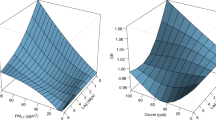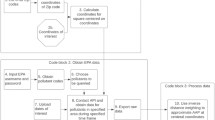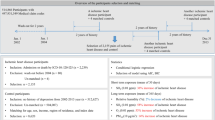Abstract
Previous studies have found strong associations between asthma morbidity and major ambient air pollutants. Relatively little research has been conducted to assess whether age is a factor conferring susceptibility to air pollution-related asthma morbidity. We investigated the short-term relationships between asthma emergency department (ED) visits and ambient ozone (O3), carbon monoxide (CO), nitrogen dioxide (NO2), sulfur dioxide (SO2), and fine particulate matter (PM2.5) in Atlanta (1993–2009), Dallas (2006–2009), and St. Louis (2001–2007). City-specific daily time-series analyses were conducted to estimate associations by age group (0–4, 5–18, 19–39, 40–64, and 65+ years). Sub-analyses were performed stratified by race and sex. City-specific rate ratios (RRs) were combined by inverse-variance weighting to provide an overall association for each strata. The overall RRs differed across age groups, with associations for all pollutants consistently strongest for children aged 5–18 years. The patterns of association across age groups remained generally consistent when models were stratified by sex and race, although the strong observed associations among 5–18 year olds appeared to be partially driven by non-white and male patients. Our findings suggest that age is a susceptibility factor for asthma exacerbations in response to air pollution, with school-age children having the highest susceptibility.
This is a preview of subscription content, access via your institution
Access options
Subscribe to this journal
Receive 6 print issues and online access
$259.00 per year
only $43.17 per issue
Buy this article
- Purchase on Springer Link
- Instant access to full article PDF
Prices may be subject to local taxes which are calculated during checkout





Similar content being viewed by others
References
Ji M, Cohan DS, Bell ML . Meta-analysis of the association between short-term exposure to ambient ozone and respiratory hospital admissions. Environ Res Lett 2011; 6: pii: 024006.
Andersen ZJ, Wahlin P, Raaschou-Nielsen O, Scheike T, Loft S . Ambient particle source apportionment and daily hospital admissions among children and elderly in Copenhagen. J Expo Sci Environ Epidemiol 2007; 17: 625–636.
Ko FW, Tam W, Wong TW, Lai CK, Wong GW, Leung TF et al. Effects of air pollution on asthma hospitalization rates in different age groups in Hong Kong. Clin Exp Allergy 2007; 37: 1312–1319.
Lavigne E, Villeneuve PJ, Cakmak S . Air pollution and emergency department visits for asthma in Windsor, Canada. Can J Public Health 2012; 103: 4–8.
Silverman RA, Ito K . Age-related association of fine particles and ozone with severe acute asthma in New York City. J Allergy Clin Immunol 2010; 125: 367–373, e5.
Son JY, Lee JT, Park YH, Bell ML . Short-term effects of air pollution on hospital admissions in Korea. Epidemiology 2013; 24: 545–554.
Villeneuve PJ, Chen L, Rowe BH, Coates F . Outdoor air pollution and emergency department visits for asthma among children and adults: a case-crossover study in northern Alberta, Canada. Environ Health 2007; 6: 40.
Wang KY, Chau TT . An association between air pollution and daily outpatient visits for respiratory disease in a heavy industry area. PLoS One 2013; 8: e75220.
Vinikoor-Imler LC, Owens EO, Nichols JL, Ross M, Brown JS, Sacks JD . Evaluating potential response-modifying factors for associations between ozone and health outcomes: a weight-of-evidence approach. Environ Health Perspect 2014; 122: 1166–1176.
Rudd RA, Moorman JE . Asthma incidence: data from the National Health Interview Survey, 1980-1996. J Asthma 2007; 44: 65–70.
Salvi S . Health effects of ambient air pollution in children. Paediatr Respir Rev 2007; 8: 275–280.
Trasande L, Thurston GD . The role of air pollution in asthma and other pediatric morbidities. J Allergy Clin Immunol 2005; 115: 689–699.
Bateson TF, Schwartz J . Children's response to air pollutants. J Toxicol Environ Health A 2008; 71: 238–243.
Mathieu-Nolf M . Poisons in the air: a cause of chronic disease in children. J Toxicol Clin Toxicol 2002; 40: 483–491.
Strickland MJ, Darrow LA, Klein M, Flanders WD, Sarnat JA, Waller LA et al. Short-term associations between ambient air pollutants and pediatric asthma emergency department visits. Am J Respir Crit Care Med 2010; 182: 307–316.
Dominici F, Peng RD, Bell ML, Pham L, McDermott A, Zeger SL et al. Fine particulate air pollution and hospital admission for cardiovascular and respiratory diseases. JAMA 2006; 295: 1127–1134.
Lin M, Chen Y, Burnett RT, Villeneuve PJ, Krewski D . The influence of ambient coarse particulate matter on asthma hospitalization in children: case-crossover and time-series analyses. Environ Health Perspect 2002; 110: 575–581.
Norris G, YoungPong SN, Koenig JQ, Larson TV, Sheppard L, Stout JW . An association between fine particles and asthma emergency department visits for children in Seattle. Environ Health Perspect 1999; 107: 489–493.
Tecer LH, Alagha O, Karaca F, Tuncel G, Eldes N . Particulate matter (PM(2.5), PM(10-2.5), and PM(10)) and children's hospital admissions for asthma and respiratory diseases: a bidirectional case-crossover study. J Toxicol Environ Health A 2008; 71: 512–520.
Ivy D, Mulholland JA, Russell AG . Development of ambient air quality population-weighted metrics for use in time-series health studies. J Air Waste Manag Assoc 2008; 58: 711–720.
Winquist A, Schauer JJ, Turner JR, Klein M, Sarnat SE . Impact of ambient fine particulate matter carbon measurement methods on observed associations with acute cardiorespiratory morbidity. J Eposure Sci Environ Epidemiol 2014; 25: 215–221.
Sarnat SE, Winquist A, Schauer JJ, Turner JR, Sarnat JA . Fine particulate matter components and emergency department visits for cardiovascular and respiratory diseases in the St. Louis, Missouri-Illinois, metropolitan area. Environ Health Perspect 2015; 123: 437–444.
Winquist A, Klein M, Tolbert P, Sarnat SE . Power estimation using simulations for air pollution time-series studies. Environ Health 2012; 11: 68.
Grineski SE, Staniswalis JG, Peng Y, Atkinson-Palombo C . Children's asthma hospitalizations and relative risk due to nitrogen dioxide (NO2): effect modification by race, ethnicity, and insurance status. Environ Res 2010; 110: 178–188.
Strickland MJ, Klein M, Flanders WD, Chang HH, Mulholland JA, Tolbert PE et al. Modification of the effect of ambient air pollution on pediatric asthma emergency visits: susceptible subpopulations. Epidemiology 2014; 25: 843–850.
Wendt JK, Symanski E, Stock TH, Chan W, Du XL . Association of short-term increases in ambient air pollution and timing of initial asthma diagnosis among Medicaid-enrolled children in a metropolitan area. Environ Res 2014; 131: 50–58.
Nachman KE, Parker JD . Exposures to fine particulate air pollution and respiratory outcomes in adults using two national datasets: a cross-sectional study. Environ Health 2012; 11: 25.
Crocker D, Brown C, Moolenaar R, Moorman J, Bailey C, Mannino D et al. Racial and ethnic disparities in asthma medication usage and health-care utilization: data from the National Asthma Survey. Chest 2009; 136: 1063–1071.
Law HZ, Oraka E, Mannino DM . The role of income in reducing racial and ethnic disparities in emergency room and urgent care center visits for asthma-United States, 2001-2009. J Asthma 2011; 48: 405–413.
Roy A, Wisnivesky JP . Racial and ethnic differences in the use of environmental control practices among children with asthma. J Asthma 2010; 47: 507–512.
Acknowledgements
The authors would like to acknowledge the contributions of members of the Southeastern Center for Air Pollution and Epidemiology (SCAPE) research group, particularly Paige Tolbert, for their thoughtful feedback on data analysis approaches and results interpretation. This publication is based in part upon information obtained through the Dallas Fort Worth Hospital Council Foundation Information and Quality Services Center’s collaborative hospital data initiative, the Georgia Hospital Association, and the Missouri Hospital Association. We are grateful for the support of all participating hospitals. This work was supported by a Clean Air Research Center grant to Emory University and the Georgia Institute of Technology from the US Environmental Protection Agency (USEPA, grant RD834799). This publication was also made possible by grants to Emory University from the USEPA (grant R82921301-0), the National Institutes of Health (grant 5T32ES012160), the National Institute of Environmental Health Sciences (grant R01ES11294), and the Electric Power Research Institute (grants EP-P27723/C13172, EP-P4353/C2124, EP-P34975/C15892, EP-P45572/C19698, and EP-P25912/C12525). The content of this publication is solely the responsibility of the authors and does not necessarily represent the official views of the National Institutes of Health or the USEPA. Further, USEPA does not endorse the purchase of any commercial products or services mentioned in the publication.
Author information
Authors and Affiliations
Corresponding author
Ethics declarations
Competing interests
The authors declare no conflict of interest.
Additional information
Supplementary Information accompanies the paper on the Journal of Exposure Science and Environmental Epidemiology website
Supplementary information
Rights and permissions
About this article
Cite this article
Alhanti, B., Chang, H., Winquist, A. et al. Ambient air pollution and emergency department visits for asthma: a multi-city assessment of effect modification by age. J Expo Sci Environ Epidemiol 26, 180–188 (2016). https://doi.org/10.1038/jes.2015.57
Received:
Accepted:
Published:
Issue Date:
DOI: https://doi.org/10.1038/jes.2015.57
Keywords
This article is cited by
-
Impacts of residential indoor air quality and environmental risk factors on adult asthma-related health outcomes in Chicago, IL
Journal of Exposure Science & Environmental Epidemiology (2023)
-
Unencapsulated and washable two-dimensional material electronic-textile for NO2 sensing in ambient air
Scientific Reports (2022)
-
Association between ambient air pollution and cause-specific mortality in Cape Town, Durban, and Johannesburg, South Africa: any susceptible groups?
Environmental Science and Pollution Research (2021)
-
A multi-pollutant model: a method suitable for studying complex relationships in environmental epidemiology
Air Quality, Atmosphere & Health (2020)
-
Association between air pollutants and outpatient and emergency hospital visits for childhood asthma in Shenyang city of China
International Journal of Biometeorology (2020)



